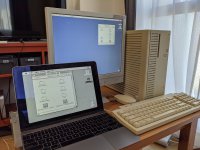sfiera
Well-known member
Weekend project:

Lower left, a Mini vMac LTOU client. Upper right, a Quadra serving its hard drive with AFP over EtherTalk. Off-screen, an RPi running a bridge between the two.
I started with bbraun’s abridge, converted it to Go, and extended it to support LTOU. It took basically the weekend to sort everything out, but it appears to work. Still some stuff I’m not so confident about. For example, I think EtherTalk always uses extended DDP headers; I think LocalTalk does both kinds but I’ve only seen short headers, and I don’t really know how networks are supposed to work.
Repo: https://github.com/sfiera/multitalk

Lower left, a Mini vMac LTOU client. Upper right, a Quadra serving its hard drive with AFP over EtherTalk. Off-screen, an RPi running a bridge between the two.
I started with bbraun’s abridge, converted it to Go, and extended it to support LTOU. It took basically the weekend to sort everything out, but it appears to work. Still some stuff I’m not so confident about. For example, I think EtherTalk always uses extended DDP headers; I think LocalTalk does both kinds but I’ve only seen short headers, and I don’t really know how networks are supposed to work.
Repo: https://github.com/sfiera/multitalk
